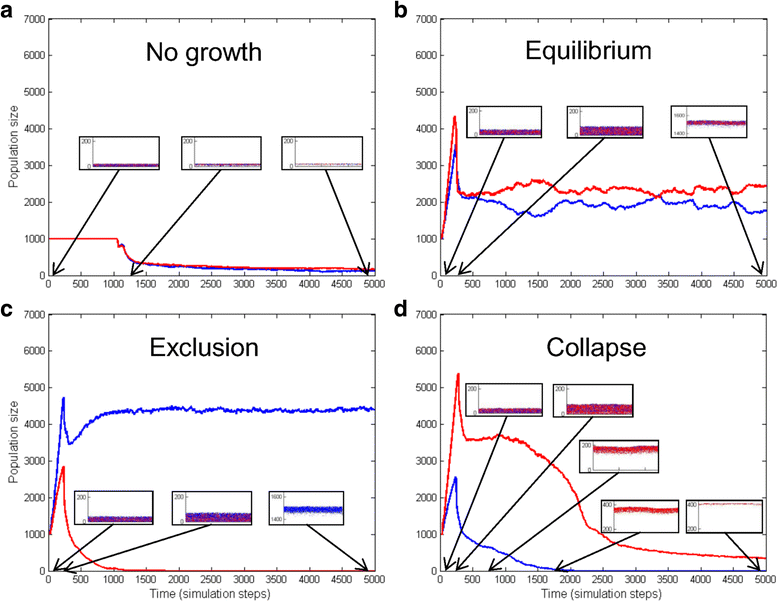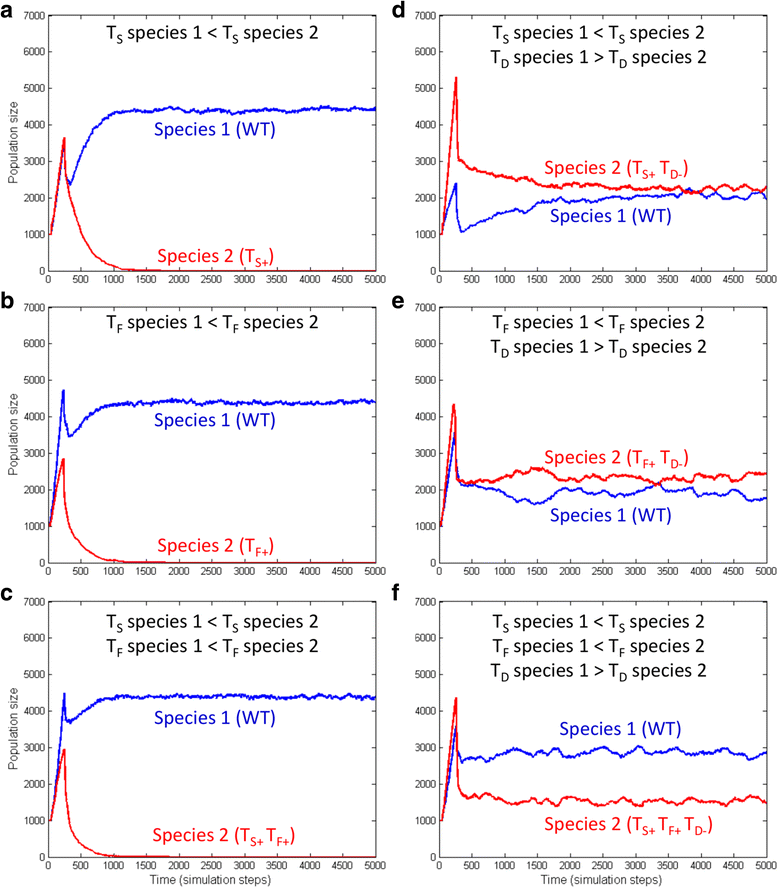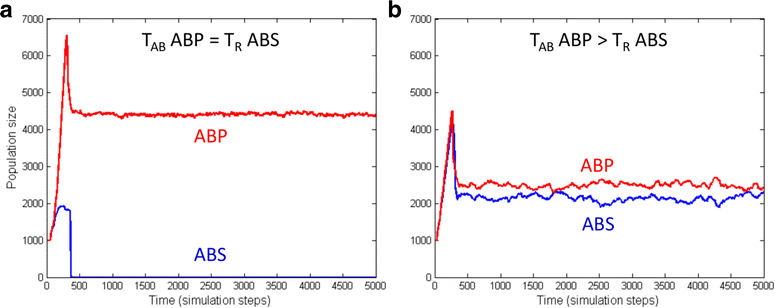Differential signal sensitivities can contribute to the stability of multispecies bacterial communities
- PMID: 28915909
- PMCID: PMC5602943
- DOI: 10.1186/s13062-017-0192-3
Differential signal sensitivities can contribute to the stability of multispecies bacterial communities
Abstract
Background: Bacterial species present in multispecies microbial communities often react to the same chemical signal but at vastly different concentrations. The existence of different response thresholds with respect to the same signal molecule has been well documented in quorum sensing which is one of the best studied inter-cellular signalling mechanisms in bacteria. The biological significance of this phenomenon is still poorly understood, and cannot be easily studied in nature or in laboratory models. The aim of this study is to establish the role of differential signal response thresholds in stabilizing microbial communities.
Results: We tested binary competition scenarios using an agent-based model in which competing bacteria had different response levels with respect to signals, cooperation factors or both, respectively. While in previous scenarios fitter species outcompete slower growing competitors, we found that stable equilibria could form if the fitter species responded to a higher chemical concentration level than the slower growing competitor. We also found that species secreting antibiotic could form a stable community with other competing species if antibiotic production started at higher response thresholds.
Conclusions: Microbial communities in nature rely on the stable coexistence of species that necessarily differ in their fitness. We found that differential response thresholds provide a simple and elegant way for keeping slower growing species within the community. High response thresholds can be considered as self-restraint of the fitter species that allows metabolically useful but slower growing species to remain within a community, and thereby the metabolic repertoire of the community will be maintained.
Reviewers: This article was reviewed by Michael Gromiha, Sebastian Maurer-Stroh, István Simon and L. Aravind.
Keywords: Agent-based modelling; Antibiotic production; Microbiome; Quorum sensing; Response threshold; Self-restraint; Swarming.
Conflict of interest statement
Ethics approval and consent to participate
Not applicable.
Consent for publication
All authors have read and approved the manuscript.
Competing interests
The authors declare that they have no competing interests.
Publisher’s Note
Springer Nature remains neutral with regard to jurisdictional claims in published maps and institutional affiliations.
Figures



Similar articles
-
Bacterial quorum sensing in complex and dynamically changing environments.Nat Rev Microbiol. 2019 Jun;17(6):371-382. doi: 10.1038/s41579-019-0186-5. Nat Rev Microbiol. 2019. PMID: 30944413 Free PMC article. Review.
-
Bacterial Quorum Sensing and Microbial Community Interactions.mBio. 2018 May 22;9(3):e02331-17. doi: 10.1128/mBio.02331-17. mBio. 2018. PMID: 29789364 Free PMC article. Review.
-
Interspecies chemical communication in bacterial development.Annu Rev Microbiol. 2009;63:99-118. doi: 10.1146/annurev.micro.091208.073248. Annu Rev Microbiol. 2009. PMID: 19566421 Review.
-
Functional characterization of a three-component regulatory system involved in quorum sensing-based regulation of peptide antibiotic production in Carnobacterium maltaromaticum.BMC Microbiol. 2006 Oct 20;6:93. doi: 10.1186/1471-2180-6-93. BMC Microbiol. 2006. PMID: 17054797 Free PMC article.
-
Community-wide changes reflecting bacterial interspecific interactions in multispecies biofilms.Crit Rev Microbiol. 2021 May;47(3):338-358. doi: 10.1080/1040841X.2021.1887079. Epub 2021 Mar 2. Crit Rev Microbiol. 2021. PMID: 33651958 Review.
Cited by
-
The role of the microbiome in ovarian cancer: mechanistic insights into oncobiosis and to bacterial metabolite signaling.Mol Med. 2021 Apr 1;27(1):33. doi: 10.1186/s10020-021-00295-2. Mol Med. 2021. PMID: 33794773 Free PMC article. Review.
-
A widespread response of Gram-negative bacterial acyl-homoserine lactone receptors to Gram-positive Streptomyces γ-butyrolactone signaling molecules.Sci China Life Sci. 2021 Oct;64(10):1575-1589. doi: 10.1007/s11427-021-1956-8. Epub 2021 Jul 26. Sci China Life Sci. 2021. PMID: 34319534
References
Publication types
MeSH terms
Substances
LinkOut - more resources
Full Text Sources
Other Literature Sources
Medical

